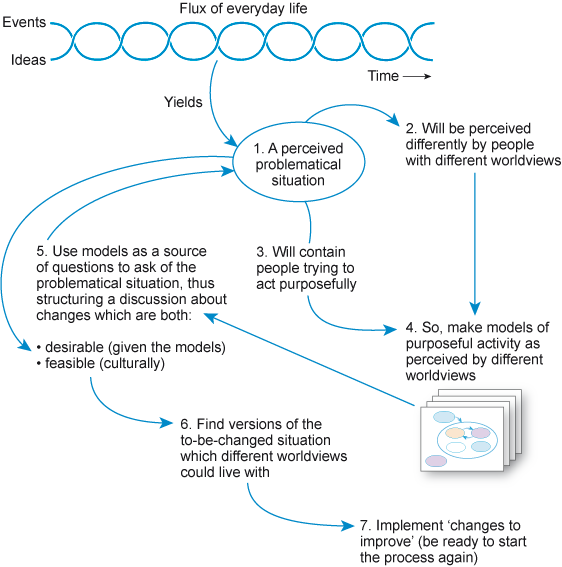TB871: Exploring Soft Systems Methodology (SSM)
Note: this is a post reflecting on one of the modules of my MSc in Systems Thinking in Practice. You can see all of the related posts in this category.
I made some notes on Chapter 5 of Systems Approaches to Making Change: A Practical Guide and then fed them into GPT-4o to summarise.

In systems thinking, Soft Systems Methodology (SSM) is as an approach for tackling complex, problematical situations. Developed by Peter Checkland and John Poulter, SSM is an action-oriented process of inquiry that helps users navigate from understanding a situation to taking action to improve it. The methodology leverages the concept of conflicting worldviews to stimulate energy and ideas for change (Checkland & Poulter, 2006, pp.202-203).
SSM’s never-ending cycle
A core tenet of SSM is its iterative nature. As practitioners take action to improve a situation, they inevitably alter the circumstances, prompting a continuous cycle of learning and adaptation. This cycle, which can be used in any human situation requiring purposeful thinking and action, ensures that SSM remains relevant over time.
Taking action to improve a problematical situation will of course itself change that situation, so that the learning cycle could in principle begin again (Ibid., p.203). Describing a situation as ‘problematical’ rather than ‘a problem’ acknowledges its complexity, dynamic nature, multiple perspectives, and the focus on ongoing improvement rather than a singular solution.
Applicability and recoverability
SSM is versatile, finding use across a wide range of human activities. It can be applied to various contexts, from small businesses to large organisations, and from the private sector to public services. The methodology is particularly valued in social research for its ‘recoverability’, a concept distinct from the ‘repeatability’ found in scientific research. In social contexts, each situation is unique, making the ability to ‘recover’ the research process through explicit frameworks crucial (Ibid., p.206).
LUMAS model
The LUMAS model (Learning for a User by a Methodology-informed Approach to a Situation) provides a structured way for users to tailor SSM to their specific needs, ensuring that the approach remains flexible and contextually relevant (Ibid., p.207).
Addressing conflicting worldviews
Unlike other systems approaches, such as the Viable System Model (VSM), SSM places a strong emphasis on the existence of conflicting worldviews. This acknowledgment is critical because it reflects the reality of human interactions, where differing perspectives are the norm. By incorporating these diverse viewpoints, SSM facilitates a more holistic and inclusive process of change (Ibid., p.207).
Core systems concept
At the heart of SSM is the idea that any system is an adaptive whole that survives through time by adapting to changes in its environment. This concept underscores the need for systems to be both desirable and culturally feasible, ensuring that proposed changes are sustainable and embraced by those involved (Checkland & Poulter, 2006, p.212).
SSM Cycle
The SSM learning cycle consists of four distinct types of activity:
- Finding out: understanding the initial problematical situation.
- Model building: creating purposeful activity models relevant to the situation.
- Using models: questioning the real situation using the models to find desirable and feasible changes.
- Taking action: implementing changes to improve the situation
(Ibid., pp.216-217).
Techniques for finding out
SSM employs several techniques to understand problematical situations deeply:
- Rich Pictures: creating a visual representation of the situation in accordance with a particular worldview or conceptualisation.
- Analysis One: identifying the client, practitioner, and issue owners
- Analysis Two: exploring the roles, norms, and values within the situation
- Analysis Three: examining power dynamics and political aspects
(Ibid., pp.221-228).
Root definitions and CATWOE
Root definitions are a crucial part of SSM, defining the purposeful activities within the system. The CATWOE analysis (Customers, Actors, Transformation process, Worldview, Owner, and Environmental constraints) helps in considering all critical aspects of these activities (Ibid., pp.228-232).
Seven principles of SSM
The methodology is underpinned by seven principles, which guide practitioners through the process and ensure that SSM remains adaptable in various contexts. These principles emphasise the importance of understanding multiple perspectives, engaging in continuous learning, and maintaining a flexible approach to problem-solving. The seven principles are:
- Structured flexibility: Maintaining flexibility within a structured approach (Ibid., p.244).
- Real-world focus: Emphasising real-world problem situations.
- Worldview clarification: Making explicit the different worldviews involved.
- Social process: Understanding the social nature of the methodology.
- Iterative learning: Recognising that learning is an iterative process.
- Organised reflection: Structuring reflection on the situation.
- Action to improve: Focusing on taking action to improve situations.
The ‘light-footedness’ of SSM
A distinctive feature of SSM is its ‘light-footedness’. This quality allows practitioners to handle complex situations without becoming bogged down by rigid procedures or overly formalised structures. It encourages an agile and responsive approach, suitable for the unique demands of each situation (Ibid., p.250).
SSM offers a rich framework for addressing complex, messy situations. By embracing conflicting worldviews, encouraging continuous learning, and emphasising adaptability, SSM provides a powerful tool for making meaningful change in an ever-changing world.
References
Checkland, P. & Poulter, J. (2006) ‘Soft Systems Methodology’, in Reynolds, M. and Holwell, S. (eds.) Systems approaches to making change: a practical guide. 2nd edn. Milton Keynes: The Open University/London: Springer, pp.201-253.
Image: Yomex Owo

